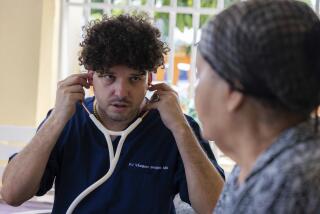Words That Heal : As Translator at Orange’s St. Joseph Hospital, ‘Mr. X’ Calms Fearful Patients and Helps Them Get the Right Care
- Share via
ORANGE — It’s been one hectic morning for Xavier Espinoza.
He’s barely three hours into his shift as an interpreter at St. Joseph Hospital and he’s already covered more distance and visited more patients than some doctors will see all day.
He begins by meeting with Josephine Vargas, a 54-year-old diabetic dialysis patient from Santa Ana. Vargas, who also has high blood pressure and suffers with arthritis, fingers a lime-green rosary as Espinoza interprets a tedious series of instructions designed to help Vargas stabilize her health.
He is then called to the second floor of the surgical ward, where chaplain intern Phyllis Behrle wonders whether the Latino patient in room 237 would like to tune out of a “Little House on the Prairie” rerun long enough to have a prayer said to cure her kidney ailment.
Several minutes later, prayer accomplished, he climbs a flight of stairs and meets up with a nurse who asks him to translate medical discharge instructions. Her patient, who checked into the hospital four days earlier complaining of intense chest pains, is ready to go home.
Before long, Espinoza is over in room 311 of the postpartum wing, cradling a newborn named Ana and reviewing feeding, skin care and diapering instructions with the baby’s mother, 22-year-old Vianey Ortiz.
As he demonstrates how to clean the stump of the baby’s umbilical cord, his beeper sounds. He is needed in the emergency room, where an 18-month-old girl with an gash on her forehead is waiting to be admitted. As he makes his way down the hall toward the ER, his beeper goes off again. Over the next hour, it will scream for attention eight more times.
The breakneck pace is not for the faint of heart. But for Espinoza, 31, it’s just another day at the office.
As one of St. Joseph’s three staff interpreters, his job at the 450-bed hospital is to help bridge the communication gap between doctors and nurses who speak only English and a growing patient population that does not.
It’s a demand that keeps Espinoza on his feet and on the move for much of his 12-hour-shift.
“Sometimes I get a little harried, but I think I’ve got the best job in the hospital,” says Espinoza, who lives in Garden Grove with his wife, Joy, and their 6-month-old daughter, Aria Sonora. “I get to float in and out of all these different little worlds, doing what I can to help, and then moving on. Each floor and each wing of the hospital has its own drama and its own cast of characters. For someone who thrives on variety as much as I do, it’s perfect.”
Espinoza grew up speaking English and Spanish, and through community college courses also learned French, Italian, Portuguese and sign language.
He started at St. Joseph in the medical records department when he was 19 and transferred to the Interpreter Services department in 1981. He estimates that over the past eleven years, he’s interpreted for more than 26,000 non-English-speaking patients, 95% of whom have been Latino.
It’s a service that’s become increasingly essential as the complexion of Orange County continues to change.
In 1991, Espinoza and the hospital’s two other interpreters, 10-year veteran Luci Roque and part-timer Carl Houghton, made a total of 11,848 personal inpatient and outpatient contacts. They also fielded 3,793 telephone calls.
While no official statistics are available to document what percentage of the total patient population requires interpreting services, some doctors and nurses at St. Joseph estimate it could be as high as 35% to 50%--most of them in Spanish. On the rare occasion when an Asian-speaking patient needs an interpreter, the staff turns to Vietnamese or Laotian nurses and lab technicians.
Tess Pane, director of women’s services and interim supervisor of the interpreter services department for the past year, says that as Orange County’s Latino population continues to grow, so has the hospital administration’s recognition that interpreters are no longer a luxury, but a necessity.
“Twenty years ago, I worked at a hospital in El Paso where you would get (penalized) if you spoke any language other than English,” recalls Pane. “Now you can walk through the hospital and hear all sorts of languages being spoken. Times have changed, and we’ve needed to change with it. If a hospital is going to serve the community, its staff needs to be able to communicate with members of that community.”
Dr. Jon Blair, chair of St. Joseph’s emergency department, agrees.
“When you’re dealing with people in crisis, the nuances of their responses and reactions are critical,” says Blair. “You need to be sure that they fully understand what’s happening, why it’s happening and what their options are.”
Blair says Espinoza not only makes that possible, but does so in ways that save the emergency room doctors and nurses time and energy.
“Xavier’s been doing this so long that he knows a lot about medicine,” says Blair. “He knows what to ask and when to ask it. When he’s helping to admit a patient, he anticipates questions the doctor will ask and has the answers waiting. He also has a great way with people. He’s not afraid to make eye contact or to hold someone’s hand. He cares about people, and it shows.”
Emergency room charge nurse Artie Killen, who calls Espinoza “Mr. X,” says she can’t imagine running the emergency room these days without having the interpreting services department a phone call away.
“Most of the nurses here know enough Spanish to get by in a pinch,” says Killen. “But that’s not enough. When patients feel that they’re being understood, they’re a lot more comfortable and are easier to deal with. Xavier and the others are real lifesavers. Sometimes they’re so busy that we have to wait a while for them to make it down here, but I can’t imagine what we’d do without them.”
Espinoza says that while translating conversations between patient and doctor is his top priority, he makes it his job to pay as much attention to what isn’t being said as to what is.
“A lot of non-English-speaking patients are intimidated by the medical system,” he explains. “They’re in a strange place where they don’t understand what’s going on, so often they withdraw. Sometimes they’ll complain to me about a symptom and then ask me not to tell anyone else. They think that if they mention it, the doctors or nurses won’t like them or will see them as troublemakers.”
The language barrier, Espinoza says, can prove every bit as exasperating for the hospital staff as it does for the patient.
“The doctors and nurses sometimes get frustrated because they find the patients so aloof,” he explains. “There are times when they try their best with their Spanish and they still don’t connect. When I arrive and deliver the same message, sometimes the nurses will say, ‘I already told him that.’ ”
Espinoza says he understands their frustration but tries to encourage the staff to maintain a sense of perspective.
“Sometimes I make a point of reminding them that it’s not the patient’s fault they don’t speak English any more than it’s their fault they don’t speak Spanish,” he says. “I’ve been around long enough to know that the people who work here are basically good-hearted. But I also know them well enough to say, ‘C’mon, what’s with you today?’ if I think someone’s overreacting.”
There are times, Espinoza says, when he’s forced to work with patients for whom attitude, not language, is the major stumbling block.
“Patients who are openly belligerent and completely unwilling to listen can be very difficult to work with,” he says. “The other thing I don’t like are patients who rely on being ignorant as an excuse. That ‘Aw, shucks, you can’t expect me to understand that’ attitude makes me crazy. A lack of knowledge or understanding is one thing. That’s what I’m here to help them gain. But a lack of willingness to learn is another.”
Espinoza says that over time, he has come to realize that the anger and hostility some patients display is really a smoke screen for fear.
“I remember one patient, a guy in his early 30s, who was in an out of here for about a year and a half battling lung cancer,” says Espinoza. “When I first met him, he and his wife were both very hostile. I was really nice to them, and I couldn’t figure out what their problem was.
“Little by little, I got to know him. After a while, he began to trust me. It turned out the reason he was so uptight was that the name he was registered under wasn’t his real name. It was the name on a Social Security card that he’d bought so that he could work in this country. Once he accepted that he was going to die, all he really wanted was to make things right and to die with his own name.”
Espinoza says he tries to instill a sense of optimism in the patients he encounters. But that can sometimes be a tall order, especially when a patient is confronting a life-threatening illness.
“One of the toughest positions for me to be in is to have to sit down with a doctor and tell a patient or a family that there is no hope,” he says. “Sometimes people are so deep in denial that the words just don’t sink in.
“You can tell a mother that her son has a brain tumor, show her the X-rays and describe all the medical implications, and all she’ll say is, ‘So when is he coming home?’ You know from her reaction that she’s not getting it. My job is to make it clear that he may not be coming home, or that if he does, he’s probably not going to live very long.”
Because he speaks their language, many patients come to regard Espinoza as an ally and are quick to ask his opinion and advice. It’s not unusual, he says, for a patient to ask what he would do if he found himself in their situation.
It’s a question that Espinoza says he’s careful never to answer.
“The fact that people come to trust me that much feels great,” he says. “That trust is a gift. But as hard as it can be sometimes, I have to maintain a certain distance. I make a point not to influence anyone’s decision. What I will do is review their options with them until they gain some clarity. I never get into ‘If I were you . . . ‘ because I just don’t feel that’s my place. It’s a responsibility I can’t assume, a choice I can’t make.”
Espinoza says what he values most about his work is the opportunity it provides to help break down cultural barriers and raise awareness.
“A lot of what I do is education,” he says. “Sometimes that means talking--and listening--to a guy who’d rather take his kid to a clinic to Tijuana because he finds that system less cumbersome and intimidating.
“Other times it means explaining to a nurse that the reason 20 relatives are visiting an old woman down the hall is because the sense of family tends to be much stronger in the Hispanic culture.”
Increasing awareness, Espinoza says, is a step toward improving the quality of medical care.
“After all, we’re providing human services,” he says. “The more we understand about the people we’re caring for, the better care we can provide them.”
More to Read
Sign up for Essential California
The most important California stories and recommendations in your inbox every morning.
You may occasionally receive promotional content from the Los Angeles Times.










